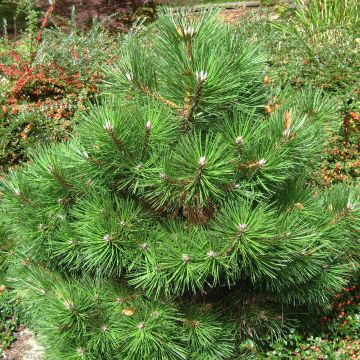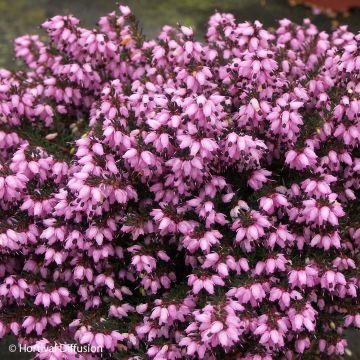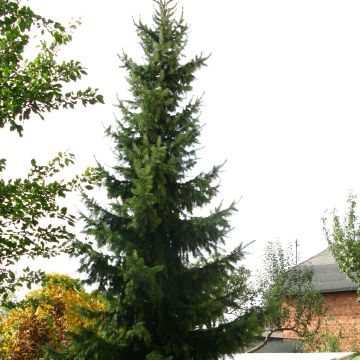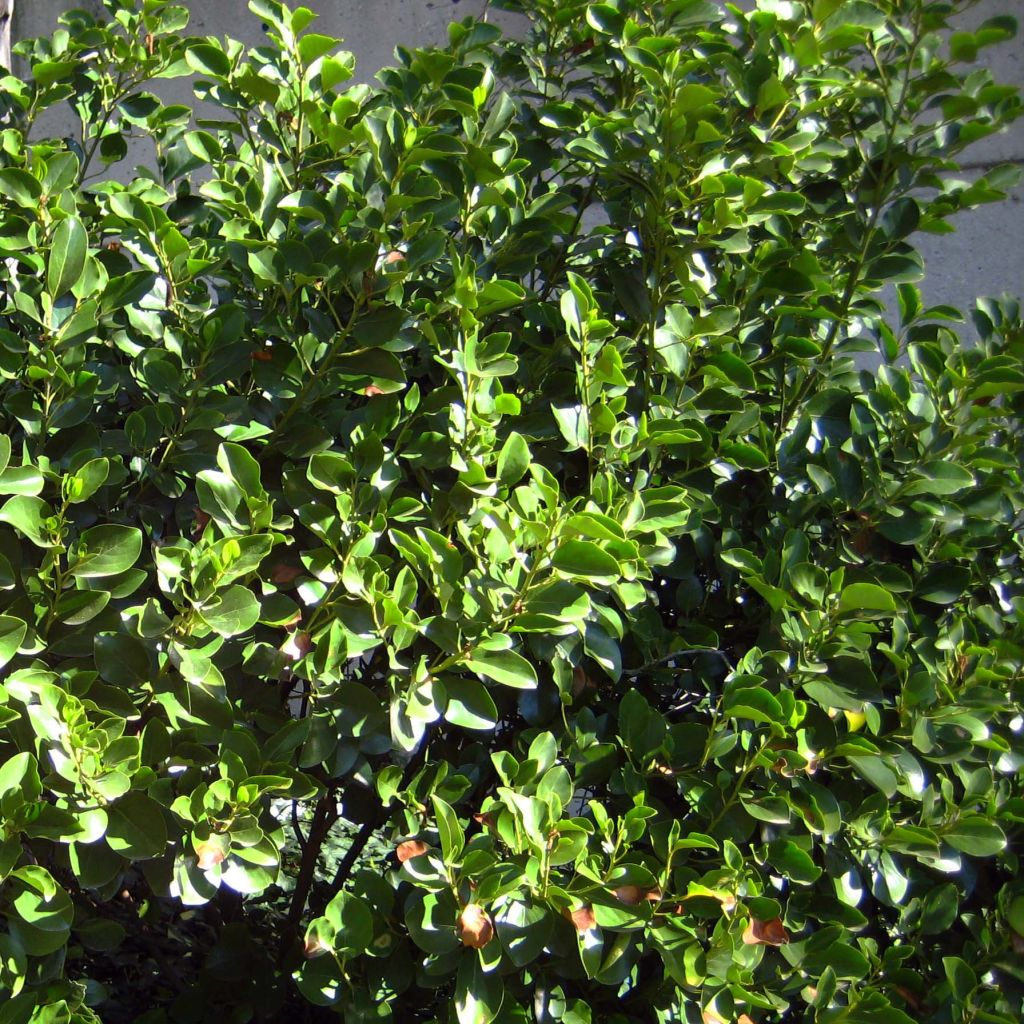

New Zealand broadleaf - Griselinia littoralis
New Zealand broadleaf - Griselinia littoralis
Griselinia littoralis
New Zealand Broadleaf, Kapuka, New Zealand Laurel, New Zealand Privet
My adventure with the Griselinia littoralis ordered from Promesse de Fleurs turned out to be a story of resilience and pleasant surprises. Considered the most delicate member of my order, I was apprehensive about its first winter in my Belgian garden, far from the mild climates of the Mediterranean zone. However, my fears quickly dissipated. Against all expectations, this plant showed impressive robustness. Not only did it survive the winter without losing a single leaf, but it maintained its proud and upright posture, defying the cold and snow with unmatched grace. Even more delightful, the arrival of spring is marked by the emergence of new small branches, a promise of growth and renewal. This experience exceeded my expectations and demonstrated that Griselinia littoralis is much more than a mere ornamental plant; it is a symbol of strength and adaptability. I would like to thank Promesse de Fleurs for their wise choice of resilient and adaptable plants, even in the most unfavorable climates. The survival and development of this plant in my Belgian garden testify to the exceptional quality of the selections offered by Promesse de Fleurs. I am more than satisfied with my purchase and highly recommend this nursery to anyone looking to introduce plants that can thrive and prosper, even in the most challenging conditions. A big congratulations on your expertise and passion!
Thierry (Le jardin de Ramioul - Belgique), 16/03/2024
This item cannot be shipped to the selected country
Delivery charge from €5.90
Delivery charge from €5.90
More information
Schedule delivery date,
and select date in basket
This plant carries a 24 months recovery warranty
More information
We guarantee the quality of our plants for a full growing cycle, and will replace at our expense any plant that fails to recover under normal climatic and planting conditions.
From €5.90 for pickup delivery and €6.90 for home delivery
Express home delivery from €8.90.
From €5.90 for pickup delivery and €6.90 for home delivery
Express home delivery from €8.90.

Does this plant fit my garden?
Set up your Plantfit profile →
Description
The Griselinia littoralis, also known as New Zealand broadleaf or English privet, is an evergreen bush ideal for coastal gardens. With its shimmering apple green foliage, rapid growth, and dense habit, it is resistant to summer drought and sea spray, making it one of the most planted species for windbreak hedges. Its discreet but highly fragrant spring flowers are followed by black berries when the female plants reach maturity. Although hardy down to -10°C, this bush will appreciate a sheltered position from dry and cold winds, and is best grown in a pot that can be stored away during winter in regions prone to heavy frosts.
The Griselinia littoralis is a bush belonging to the Cornaceae family, similar to dogwoods. It is native to New Zealand and grows in the forests along the coast up to 900m (2952.8 ft) above sea level. While it can grow into a tree with multiple trunks reaching a height of 12m (39.4 ft) in its natural environment, it will not exceed 3m (9.8 ft) in height and 2.5m (6.6 ft) in width under our climates, and will remain even smaller when grown in pots. Its habit is upright, densely bushy, and almost as wide as tall. It has a fast growth rate in slightly acidic and deep soil, around 30cm (11.8 in) per year. In very alkaline soil, its growth will be significantly reduced. Its trunk and branches, quite flexible, are covered with a smooth yellow-green bark when young, becoming greyish-ochre and fissured over time. The foliage, which is more or less evergreen depending on the severity of the winter, consists of upright, ovate, incurved leaves measuring 4 to 12cm (4.7 in) in length. The texture of the young leaves is delicate and flexible. They become thick, almost succulent, leathery, and glossy when mature. Their colour is a bright acidic green, similar to that of a Granny Smith apple, with a glossy finish. The flowering, in May-June, is more abundant in full sun but still not very noticeable: it takes the form of small axillary panicles composed of about a hundred small petal-less flowers in green-yellow colour. Although often overlooked, it attracts many pollinating insects that harvest rich pollen. As this bush is dioecious, only the female plants will bear fruits, provided a male plant is planted nearby. These clusters of fruits comprise small ovoid berries, initially green, which turn black when ripe and contain only one seed.
Well adapted to coastal areas, Griselinia littoralis is often used to create hedges at the edge of gardens to protect them from wind and prying eyes. It also thrives in containers, which can be placed on a terrace or balcony. This cultivation method allows gardeners in colder regions to protect it from severe cold in an unheated greenhouse or conservatory during winter. Its height will be smaller in containers, but the plant will quickly fill the available space by spreading out. In the ground, it can also be used as a shrubbery, either alone or in combination with other evergreen bushes such as purple laurel, Photinia Pink Marble, Elaeagnus, evergreen Ceanothus, or Pittosporum. It will also help create a dense screen facing the prevailing winds on a terrace.
Report an error about the product description
New Zealand broadleaf - Griselinia littoralis in pictures
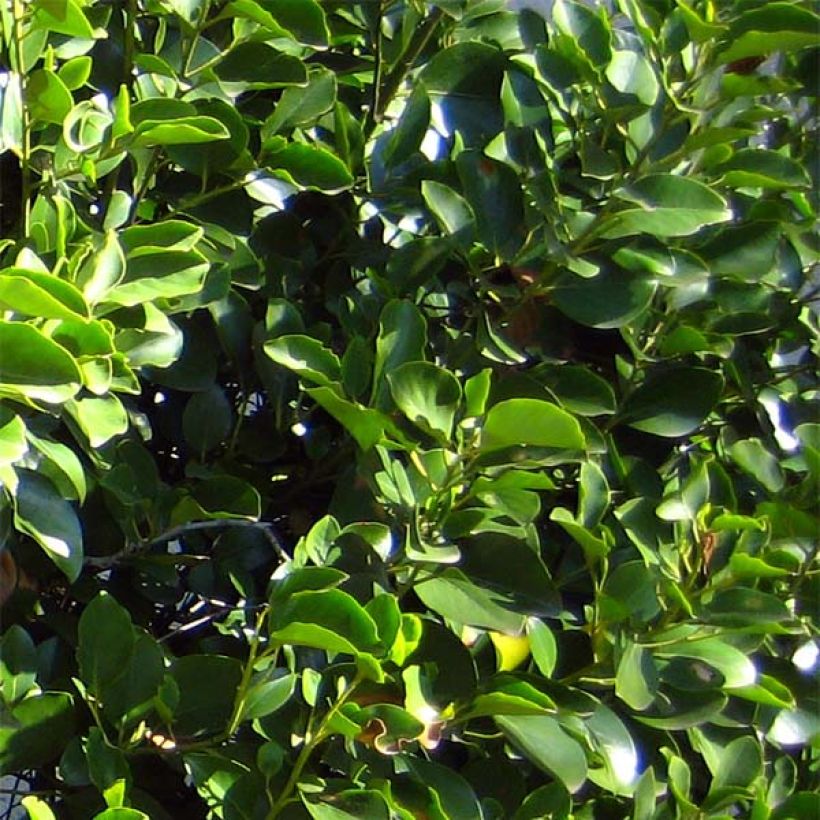

Plant habit
Flowering
Foliage
Botanical data
Griselinia
littoralis
Griseliniaceae (Cornaceae)
New Zealand Broadleaf, Kapuka, New Zealand Laurel, New Zealand Privet
Oceania
Other Griselinia
Planting and care
If you're planning to plant Griselinia littoralis, it's best to do it in spring after the last frost in cool climates. In warmer and drier regions, it's recommended to plant it in September-October during the summer. The plant can survive temperatures as low as -7/-10°C, but only if the soil is well-draining and sheltered from dry and cold winds. If the winters are frosty or freezing for extended periods of time, it is not recommended to plant Griselinia littoralis due to the possibility of the foliage becoming deciduous. For optimal growth, this bush requires a well-drained and properly loosened soil, of any type. However, for optimal results it prefers a light, sandy, and humus-rich soil with moderate amounts of limestone that retains some moisture.The bush doesn't do well in heavy and waterlogged soils during winter, but it's relatively resistant to drought once it's well-established. For best results, plant it in a sunny but not scorching or partially shaded position, especially in hot climates. Griselinia littoralis will produce more flowers if it's in the sun.
If you need to prune it, this plant can handle light pruning. It's best to do this once or twice a year, after it flowers, either at the beginning or end of summer. Simply trim the branches that are too long or tall and disrupt the plant's natural shape. Make sure to use a clean, sharp blade for the cuts to keep the plant healthy.
Insects and diseases:
The Griselinia is not susceptible to pest attacks, however, it can be vulnerable to fungal diseases in moist soils and climates, which can result in the appearance of spots on the leaves.
Planting period
Intended location
Care
-
, onOrder confirmed
Reply from on Promesse de fleurs
Evergreen shrubs
Haven't found what you were looking for?
Hardiness is the lowest winter temperature a plant can endure without suffering serious damage or even dying. However, hardiness is affected by location (a sheltered area, such as a patio), protection (winter cover) and soil type (hardiness is improved by well-drained soil).

Photo Sharing Terms & Conditions
In order to encourage gardeners to interact and share their experiences, Promesse de fleurs offers various media enabling content to be uploaded onto its Site - in particular via the ‘Photo sharing’ module.
The User agrees to refrain from:
- Posting any content that is illegal, prejudicial, insulting, racist, inciteful to hatred, revisionist, contrary to public decency, that infringes on privacy or on the privacy rights of third parties, in particular the publicity rights of persons and goods, intellectual property rights, or the right to privacy.
- Submitting content on behalf of a third party;
- Impersonate the identity of a third party and/or publish any personal information about a third party;
In general, the User undertakes to refrain from any unethical behaviour.
All Content (in particular text, comments, files, images, photos, videos, creative works, etc.), which may be subject to property or intellectual property rights, image or other private rights, shall remain the property of the User, subject to the limited rights granted by the terms of the licence granted by Promesse de fleurs as stated below. Users are at liberty to publish or not to publish such Content on the Site, notably via the ‘Photo Sharing’ facility, and accept that this Content shall be made public and freely accessible, notably on the Internet.
Users further acknowledge, undertake to have ,and guarantee that they hold all necessary rights and permissions to publish such material on the Site, in particular with regard to the legislation in force pertaining to any privacy, property, intellectual property, image, or contractual rights, or rights of any other nature. By publishing such Content on the Site, Users acknowledge accepting full liability as publishers of the Content within the meaning of the law, and grant Promesse de fleurs, free of charge, an inclusive, worldwide licence for the said Content for the entire duration of its publication, including all reproduction, representation, up/downloading, displaying, performing, transmission, and storage rights.
Users also grant permission for their name to be linked to the Content and accept that this link may not always be made available.
By engaging in posting material, Users consent to their Content becoming automatically accessible on the Internet, in particular on other sites and/or blogs and/or web pages of the Promesse de fleurs site, including in particular social pages and the Promesse de fleurs catalogue.
Users may secure the removal of entrusted content free of charge by issuing a simple request via our contact form.
The flowering period indicated on our website applies to countries and regions located in USDA zone 8 (France, the United Kingdom, Ireland, the Netherlands, etc.)
It will vary according to where you live:
- In zones 9 to 10 (Italy, Spain, Greece, etc.), flowering will occur about 2 to 4 weeks earlier.
- In zones 6 to 7 (Germany, Poland, Slovenia, and lower mountainous regions), flowering will be delayed by 2 to 3 weeks.
- In zone 5 (Central Europe, Scandinavia), blooming will be delayed by 3 to 5 weeks.
In temperate climates, pruning of spring-flowering shrubs (forsythia, spireas, etc.) should be done just after flowering.
Pruning of summer-flowering shrubs (Indian Lilac, Perovskia, etc.) can be done in winter or spring.
In cold regions as well as with frost-sensitive plants, avoid pruning too early when severe frosts may still occur.
The planting period indicated on our website applies to countries and regions located in USDA zone 8 (France, United Kingdom, Ireland, Netherlands).
It will vary according to where you live:
- In Mediterranean zones (Marseille, Madrid, Milan, etc.), autumn and winter are the best planting periods.
- In continental zones (Strasbourg, Munich, Vienna, etc.), delay planting by 2 to 3 weeks in spring and bring it forward by 2 to 4 weeks in autumn.
- In mountainous regions (the Alps, Pyrenees, Carpathians, etc.), it is best to plant in late spring (May-June) or late summer (August-September).
The harvesting period indicated on our website applies to countries and regions in USDA zone 8 (France, England, Ireland, the Netherlands).
In colder areas (Scandinavia, Poland, Austria...) fruit and vegetable harvests are likely to be delayed by 3-4 weeks.
In warmer areas (Italy, Spain, Greece, etc.), harvesting will probably take place earlier, depending on weather conditions.
The sowing periods indicated on our website apply to countries and regions within USDA Zone 8 (France, UK, Ireland, Netherlands).
In colder areas (Scandinavia, Poland, Austria...), delay any outdoor sowing by 3-4 weeks, or sow under glass.
In warmer climes (Italy, Spain, Greece, etc.), bring outdoor sowing forward by a few weeks.






































